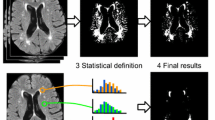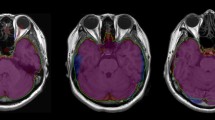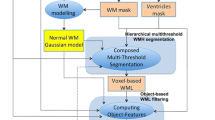Abstract
Purpose
Development of a warp-based automated brain segmentation approach of 3D fluid-attenuated inversion recovery (FLAIR) images and comparison to 3D T1-based segmentation.
Methods
3D FLAIR and 3D T1-weighted sequences of 30 healthy subjects (mean age 29.9 ± 8.3 years, 8 female) were acquired on the same 3T MR scanner. Warp-based segmentation was applied for volumetry of total gray matter (GM), white matter (WM), and 116 atlas regions. Segmentation results of both sequences were compared using Pearson correlation (r).
Results
Correlation of GM segmentation results based on FLAIR and T1 was overall good for cortical structures (mean r across all cortical structures = 0.76). Comparatively weaker results were found in the occipital lobe (r = 0.77), central region (mean r = 0.58), basal ganglia (mean r = 0.59), thalamus (r = 0.30), and cerebellum (r = 0.73). FLAIR segmentation underestimated volume of the central region compared to T1, but showed a better anatomic concordance with the occipital lobe on visual review and subcortical structures, when also compared to manual segmentation. Visual analysis of FLAIR-based WM segmentation revealed frequent misclassification of regions of high signal intensity as GM.
Conclusion
Warp-based FLAIR segmentation yields comparable results to T1 segmentation for most cortical GM structures and may provide anatomically more congruent segmentation of subcortical GM structures. Selected cortical regions, especially the central region and total WM, seem to be underestimated on FLAIR segmentation.





Similar content being viewed by others
Abbreviations
- GM:
-
Gray matter
- WM:
-
White matter
- CSF:
-
Cerebrospinal fluid
- FLAIR:
-
Fluid-attenuated inversion recovery
- AAL:
-
Automatic Anatomical Labeling
- 3D:
-
Three-dimensional
- TI:
-
Inversion time
- TR:
-
Repetition time
- TE:
-
Echo time
- FSL:
-
Functional magnetic resonance imaging of the brain (FMRIB) software library
- FAST:
-
FMRIB’s Automated Segmentation Tool
- BET:
-
Brain extraction
- AFNI:
-
Analyses of functional images
- MNI:
-
Montreal Neurological Institute
- FLIRT:
-
FMRIB’s linear image registration tool
- FNIRT:
-
FMRIB’s nonlinear image registration tool
- ICV:
-
Intracranial volume
- r :
-
Pearson correlation
- R:
-
Right
- L:
-
Left
References
Miller KL, Alfaro-Almagro F, Bangerter NK, Thomas DL, Yacoub E, Xu J, Bartsch AJ, Jbabdi S, Sotiropoulos SN, Andersson JLR, Griffanti L, Douaud G, Okell TW, Weale P, Dragonu I, Garratt S, Hudson S, Collins R, Jenkinson M, Matthews PM, Smith SM (2016) Multimodal population brain imaging in the UK Biobank prospective epidemiological study. Nat Neurosci 19:1523–1536
Bamberg F, Kauczor HU, Weckbach S, Schlett CL, Forsting M, Ladd SC, Greiser KH, Weber MA, Schulz-Menger J, Niendorf T, Pischon T, Caspers S, Amunts K, Berger K, Bülow R, Hosten N, Hegenscheid K, Kröncke T, Linseisen J, Günther M, Hirsch JG, Köhn A, Hendel T, Wichmann HE, Schmidt B, Jöckel KH, Hoffmann W, Kaaks R, Reiser MF, Völzke H, For the German National Cohort MRI Study Investigators (2015) Whole-body MR imaging in the German National Cohort: rationale, design, and technical background. Radiology 277:206–220
Fellhauer I, Zollner FG, Schroder J et al (2015) Comparison of automated brain segmentation using a brain phantom and patients with early Alzheimer’s dementia or mild cognitive impairment. Psychiatry Res 233:299–305
Lindig T, Kotikalapudi R, Schweikardt D et al (2017) Evaluation of multimodal segmentation based on 3D T1-, T2- and FLAIR-weighted images - the difficulty of choosing. Neuroimage. https://doi.org/10.1016/j.neuroimage.2017.02.016
Gatidis S, Heber SD, Storz C, Bamberg F (2016) Population-based imaging biobanks as source of big data. Radiol Med 122:430–436. https://doi.org/10.1007/s11547-016-0684-8
McCarthy CS, Ramprashad A, Thompson C, Botti JA, Coman IL, Kates WR (2015) A comparison of FreeSurfer-generated data with and without manual intervention. Front Neurosci 9:379
Lorio S, Fresard S, Adaszewski S, Kherif F, Chowdhury R, Frackowiak RS, Ashburner J, Helms G, Weiskopf N, Lutti A, Draganski B (2016) New tissue priors for improved automated classification of subcortical brain structures on MRI. Neuroimage 130:157–166
Utter AA, Basso MA (2008) The basal ganglia: an overview of circuits and function. Neurosci Biobehav Rev 32:333–342
Smith SM (2002) Fast robust automated brain extraction. Hum Brain Mapp 17:143–155
Tzourio-Mazoyer N, Landeau B, Papathanassiou D, Crivello F, Etard O, Delcroix N, Mazoyer B, Joliot M (2002) Automated anatomical labeling of activations in SPM using a macroscopic anatomical parcellation of the MNI MRI single-subject brain. Neuroimage 15:273–289
Jenkinson M, Bannister P, Brady M, Smith S (2002) Improved optimization for the robust and accurate linear registration and motion correction of brain images. Neuroimage 17:825–841
Park B, Ko JH, Lee JD, Park HJ (2013) Evaluation of node-inhomogeneity effects on the functional brain network properties using an anatomy-constrained hierarchical brain parcellation. PLoS One 8:e74935
Dale AM, Fischl B, Sereno MI (1999) Cortical surface-based analysis. I. Segmentation and surface reconstruction. Neuroimage 9:179–194
Fischl B (2012) FreeSurfer. Neuroimage 62:774–781
Fischl B, Sereno MI, Dale AM (1999) Cortical surface-based analysis. II: inflation, flattening, and a surface-based coordinate system. Neuroimage 9:195–207
Qureshi AY, Mueller S, Snyder AZ, Mukherjee P, Berman JI, Roberts TPL, Nagarajan SS, Spiro JE, Chung WK, Sherr EH, Buckner RL, on behalf of the Simons VIP Consortium (2014) Opposing brain differences in 16p11.2 deletion and duplication carriers. J Neurosci 34:11199–11211
Hansen TI, Brezova V, Eikenes L, Haberg A, Vangberg TR (2015) How does the accuracy of intracranial volume measurements affect normalized brain volumes? Sample size estimates based on 966 subjects from the HUNT MRI cohort. AJNR Am J Neuroradiol 36:1450–1456
Dell’Oglio E, Ceccarelli A, Glanz BI et al (2015) Quantification of global cerebral atrophy in multiple sclerosis from 3T MRI using SPM: the role of misclassification errors. J Neuroimaging 25:191–199
Pintzka CW, Hansen TI, Evensmoen HR, Haberg AK (2015) Marked effects of intracranial volume correction methods on sex differences in neuroanatomical structures: a HUNT MRI study. Front Neurosci 9:238
Visser E, Keuken MC, Douaud G, Gaura V, Bachoud-Levi AC, Remy P, Forstmann BU, Jenkinson M (2016) Automatic segmentation of the striatum and globus pallidus using MIST: multimodal image segmentation tool. Neuroimage 125:479–497
Visser E, Keuken MC, Forstmann BU, Jenkinson M (2016) Automated segmentation of the substantia nigra, subthalamic nucleus and red nucleus in 7T data at young and old age. Neuroimage 139:324–336
Nordenskjold R, Malmberg F, Larsson EM et al (2015) Intracranial volume normalization methods: considerations when investigating gender differences in regional brain volume. Psychiatry Res 231:227–235
Despotovic I, Goossens B, Philips W (2015) MRI segmentation of the human brain: challenges, methods, and applications. Comput Math Methods Med 2015:450341
Author information
Authors and Affiliations
Corresponding author
Ethics declarations
Funding
No funding was received for this study.
Conflict of interest
The authors declare that they have no conflict of interest.
Ethical approval
All procedures performed in the studies involving human participants were in accordance with the ethical standards of the institutional and/or national research committee and with the 1964 Helsinki Declaration and its later amendments or comparable ethical standards.
Informed consent
Informed consent was obtained from all individual participants included in the study.
Electronic supplementary material
Supplementary Table 1a
(DOCX 104 kb)
Supplementary Table 1b
(DOCX 131 kb)
Supplementary Table 2
(DOCX 40 kb)
Supplementary Table 3
(DOCX 96 kb)
ESM 1
(PDF 156 kb)
Rights and permissions
About this article
Cite this article
Beller, E., Keeser, D., Wehn, A. et al. T1-MPRAGE and T2-FLAIR segmentation of cortical and subcortical brain regions—an MRI evaluation study. Neuroradiology 61, 129–136 (2019). https://doi.org/10.1007/s00234-018-2121-2
Received:
Accepted:
Published:
Issue Date:
DOI: https://doi.org/10.1007/s00234-018-2121-2




